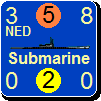Extraneous
Posts: 1810
Joined: 6/14/2008
Status: offline

|
quote:
Original: Centaur
I don't agree at all with you, extraneous...
I repeat RAW:
"Partisans are always at war with the conquering major power (and it's aligned minors) even if the partisan's controlling major power is not at war with the conquerer."
If I follow your point of view, how is it possible for a partisan unit to be controlled by the Major Power, which controls his red country? After all, he is at war with that power!
RAW:
1.1 Rules
We have arranged these rules in sequence-of-play order.
In section 2.5 of the rules, control is determined. This section comes first in any turn (before initiative). So during this phase, you determine what Major Power controls which partisans, along with determining which hexes, countries and territories every Major Powers controls. Normally, this is of course skipped. However, regarding Partisans, this is the moment control is determined in the sequence of play...
quote:
2. General concepts
2.1 Terrain
2.1.1 Hexes & hex-dots
2.1.2 Sea areas
2.1.3 Off-map areas
2.1.4 The American minimap
2.2 Zones of control
2.3 Stacking
2.4 Supply
2.4.1 When to check supply
2.4.2 Tracing supply
2.4.3 Out of supply
2.5 Control
Entities (geographical entities)
Initial control (of hex's)
Changing control (of hex's)
quote:
Control of a hex changes when:
An enemy land unit (except for partisans ~ see 13.1 Partisans (option 46) , and supply units ~ see 22.4.10 Supply units (MiF option 6)) enters it (the major power entering with the most factors if more than one); or
An island, territory, minor country or major power is conquered (see 13.7.1 Conquest); or
France is declared Vichy (see 17.1 Creation); or
It is a communist Chinese-controlled city entered by a nationalist Chinese land unit or vice versa; or
During the liberation step you return control to the original owner (see 13.7.5, reversion).
Units in hexes that change control (Naval and Air units)
2.6 Fractions
2.7 Dice
2.8 Range
Since our situation has nothing to do 2. General concepts and is followed by...
quote:
3. The Turn
After you have set up your game (see 24.1 Setup), you play a series of two-month turns until the scenario is over (this will be from 5 to 36 turns, depending on the scenario).
Both sides perform a series of activities in every turn. There are 3 stages at the start of the turn that everyone takes part in. Then there is a sequence of impulses that each side performs alternately. After those impulses are over, there are a few more stages for everyone. Then the turn is over and you start a new turn (easy isn’t it?!?).
Which outlines the sequence of events in the turn.
1) How is it possible for a partisan unit to be controlled by the Major Power, which controls his red country? After all, he is at war with that power!
2) "Partisans are always at war with the conquering major power (and it's aligned minors) even if the partisan's controlling major power is not at war with the conquerer."
Question: which major power conquered France? Answer: None. A Vichy government was installed by Germany.
Question: which major power conquered French Indo-China? Answer: None. French Indo-China was aligned by Japan.
Japan is only at war with China and has never been at war with France or French Indo-China.
Why is the partisan at war and with whom?
_____________________________
University of Science Music and Culture (USMC) class of 71 and 72 ~ Extraneous (AKA Mziln)
|
 Printable Version
Printable Version









 I agree there are some very rough parts in the RAW.
I agree there are some very rough parts in the RAW.  New Messages
New Messages No New Messages
No New Messages Hot Topic w/ New Messages
Hot Topic w/ New Messages Hot Topic w/o New Messages
Hot Topic w/o New Messages Locked w/ New Messages
Locked w/ New Messages Locked w/o New Messages
Locked w/o New Messages Post New Thread
Post New Thread